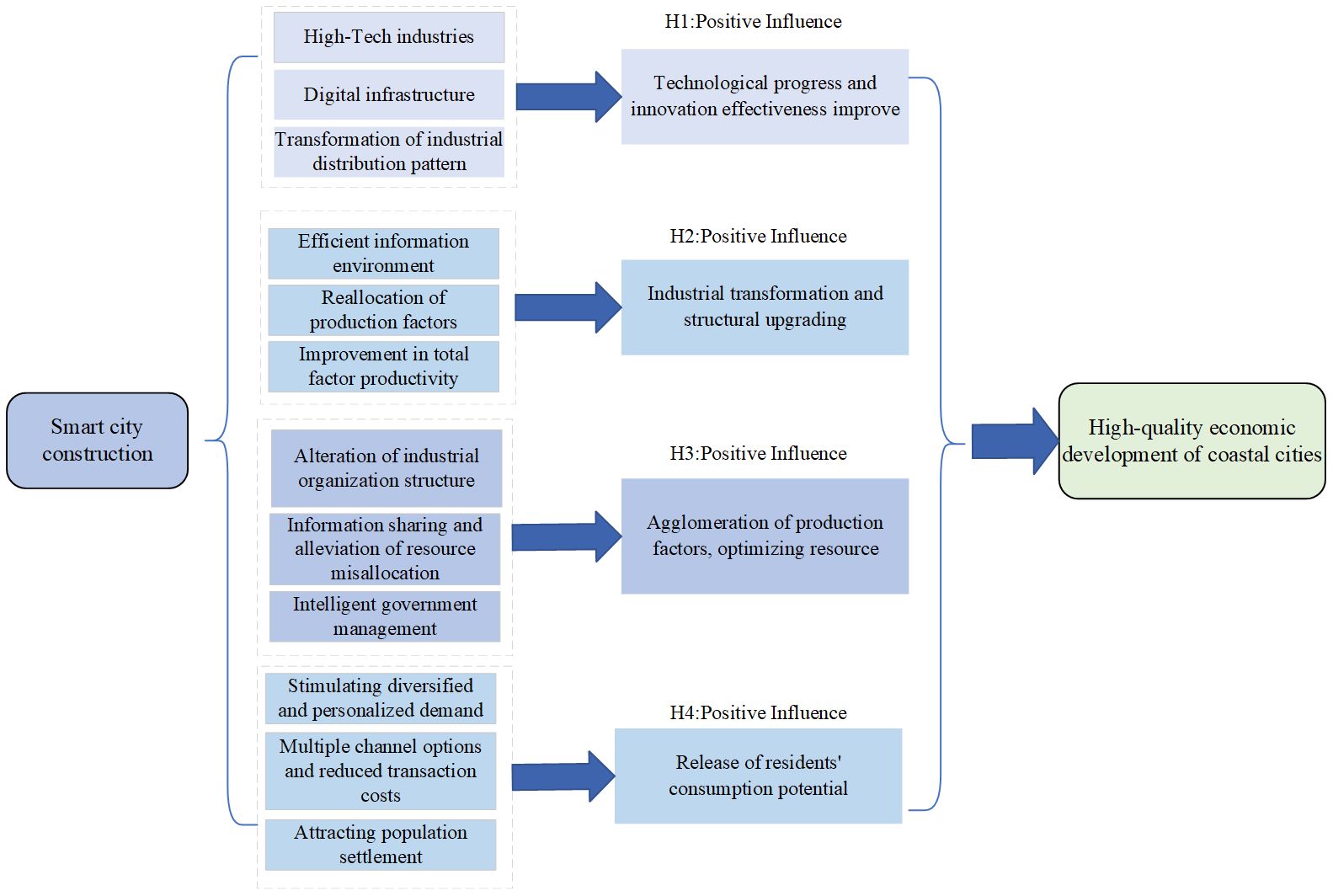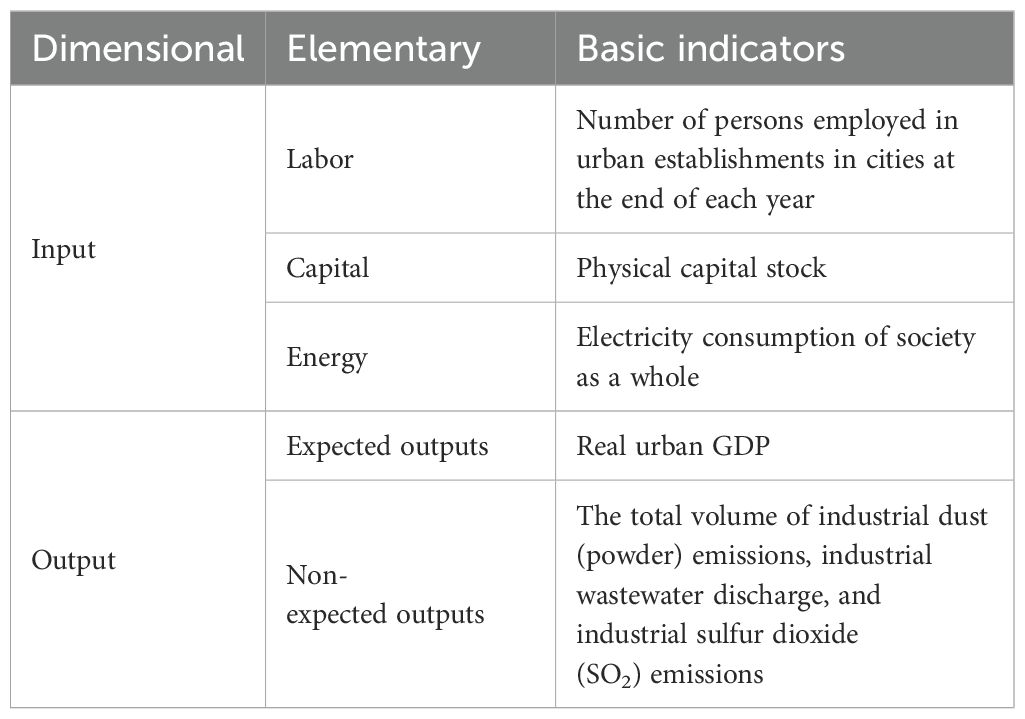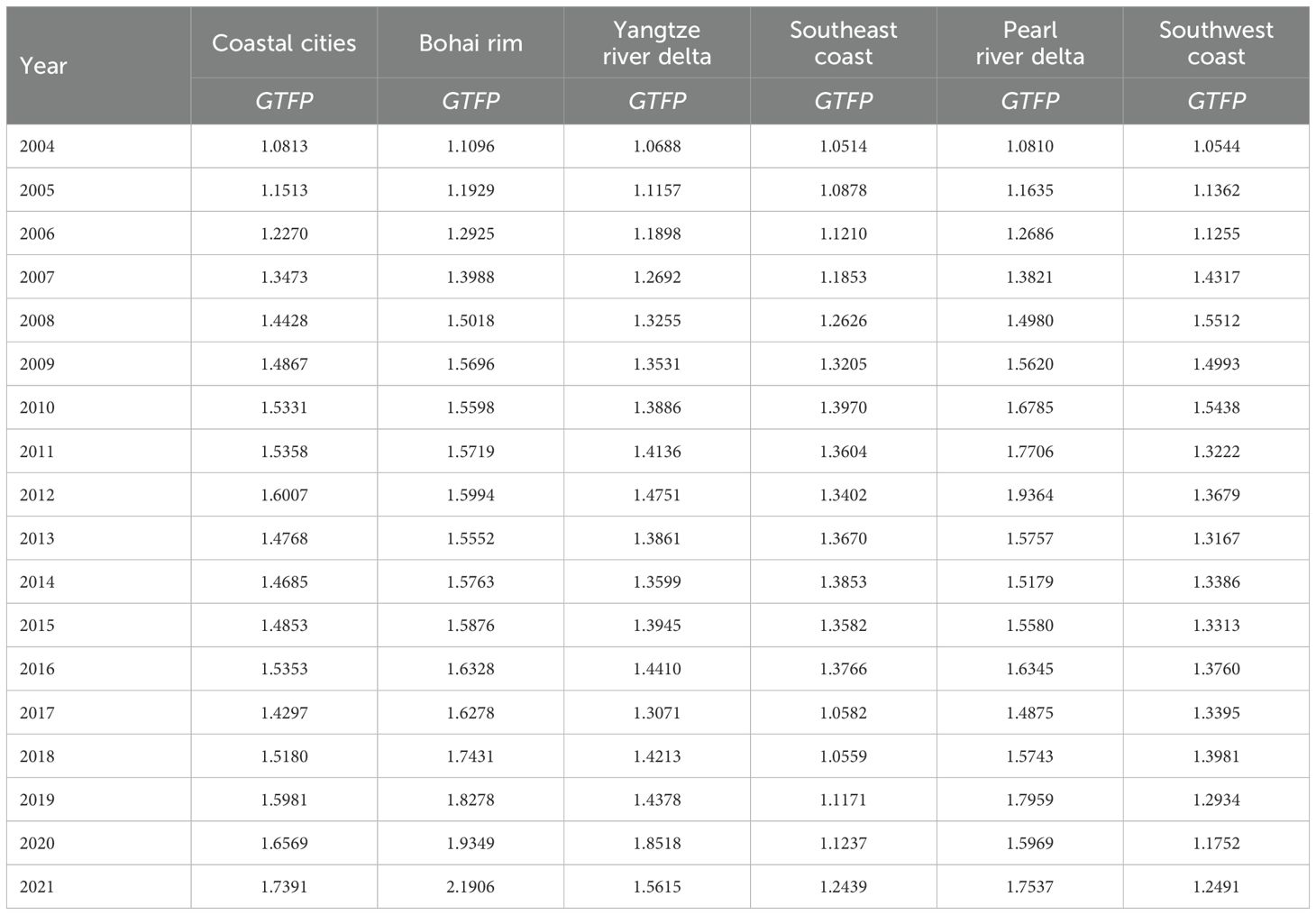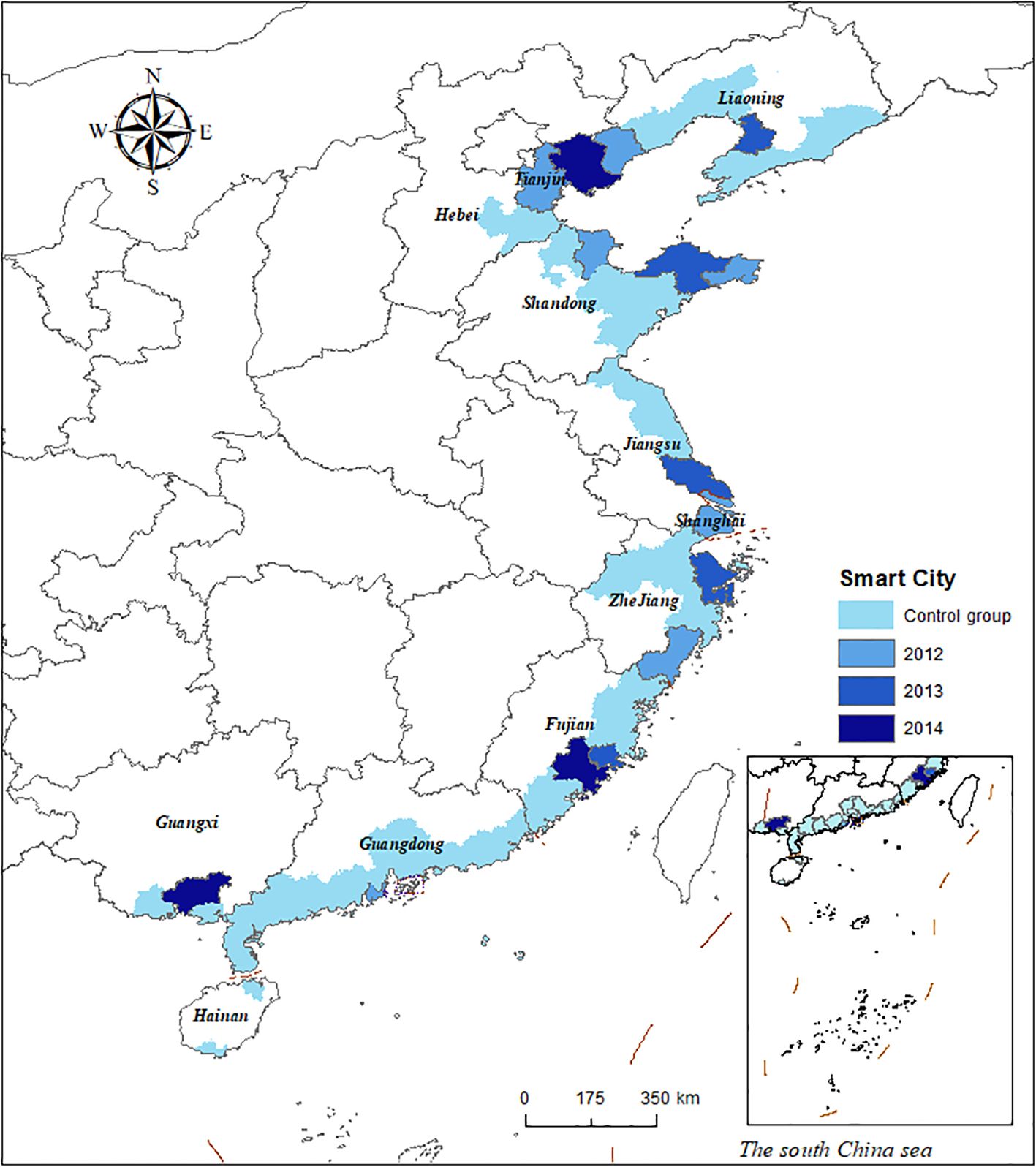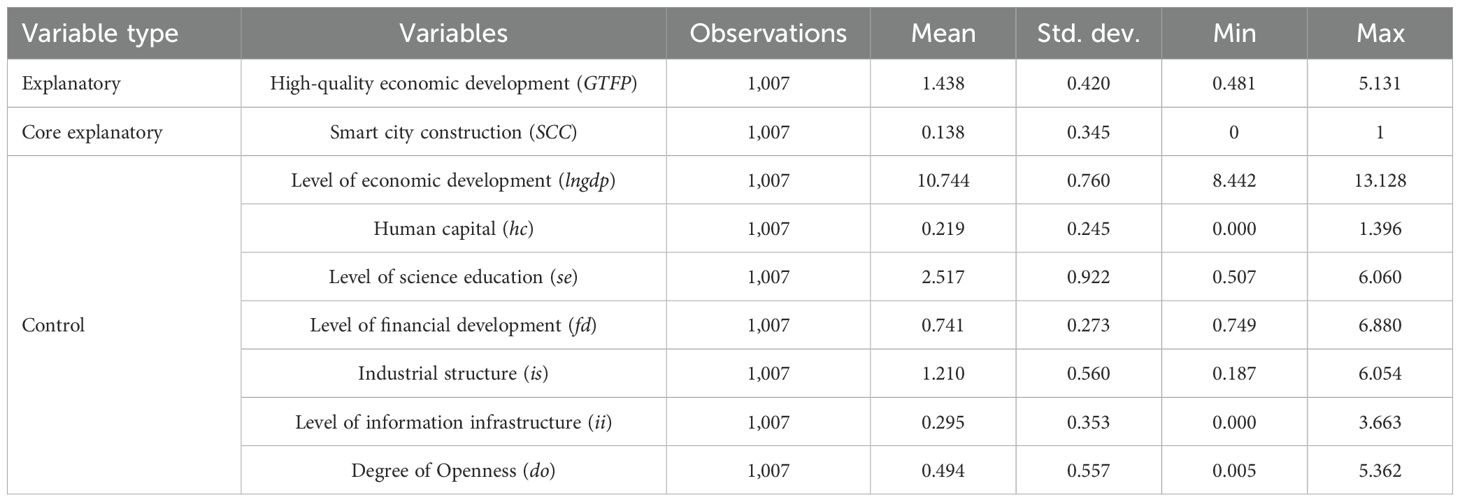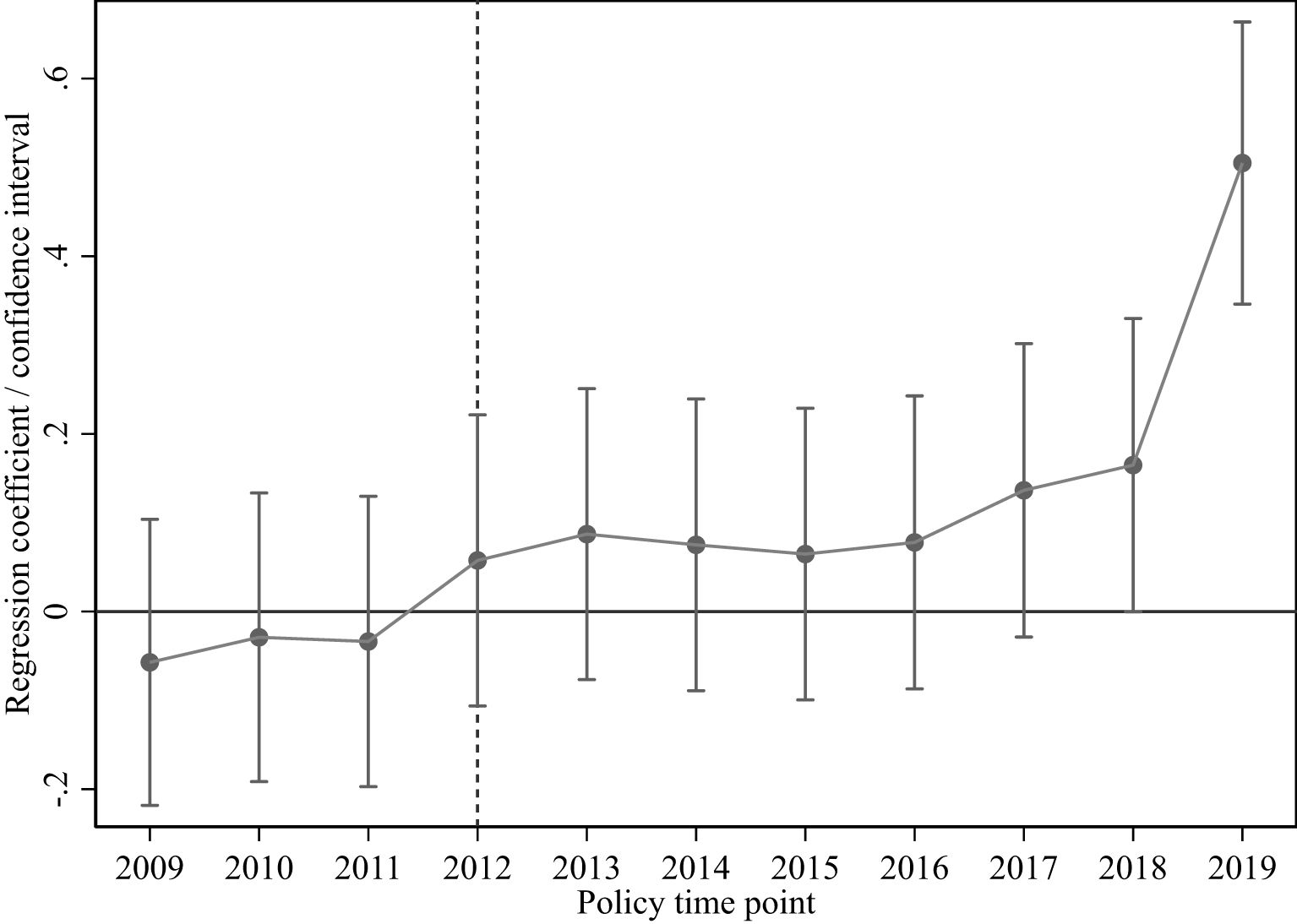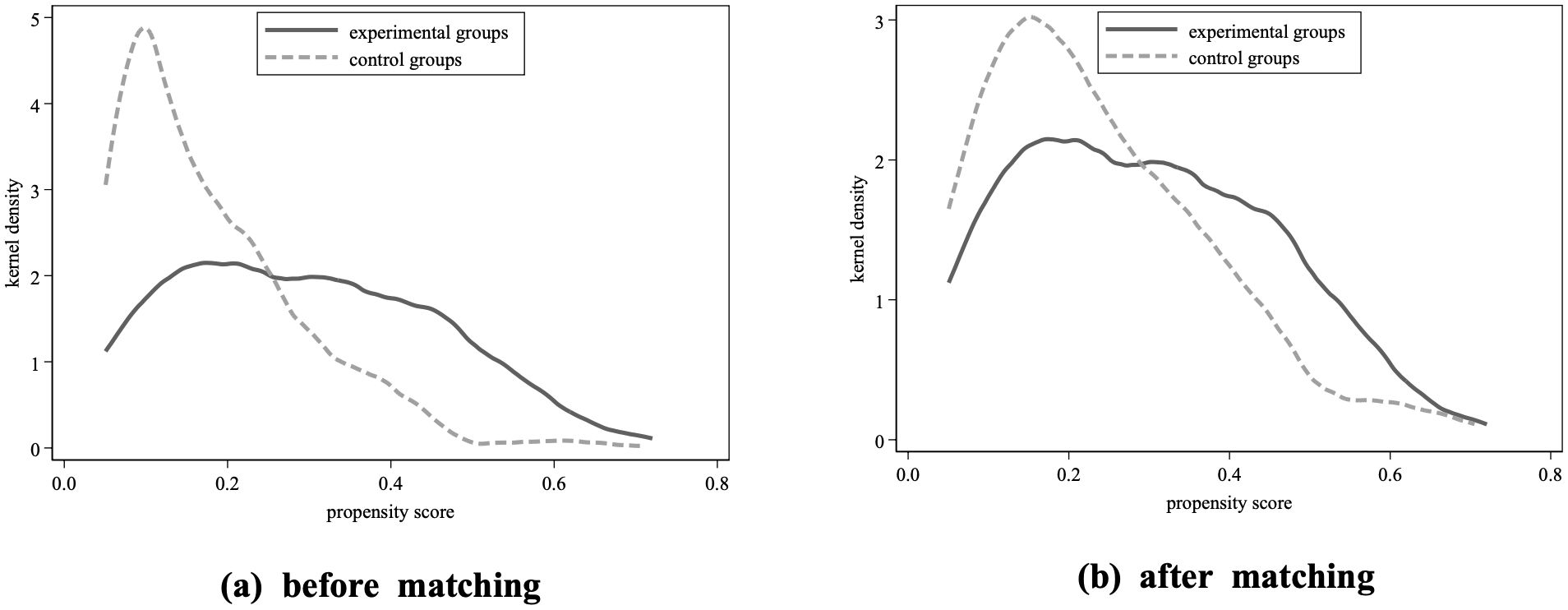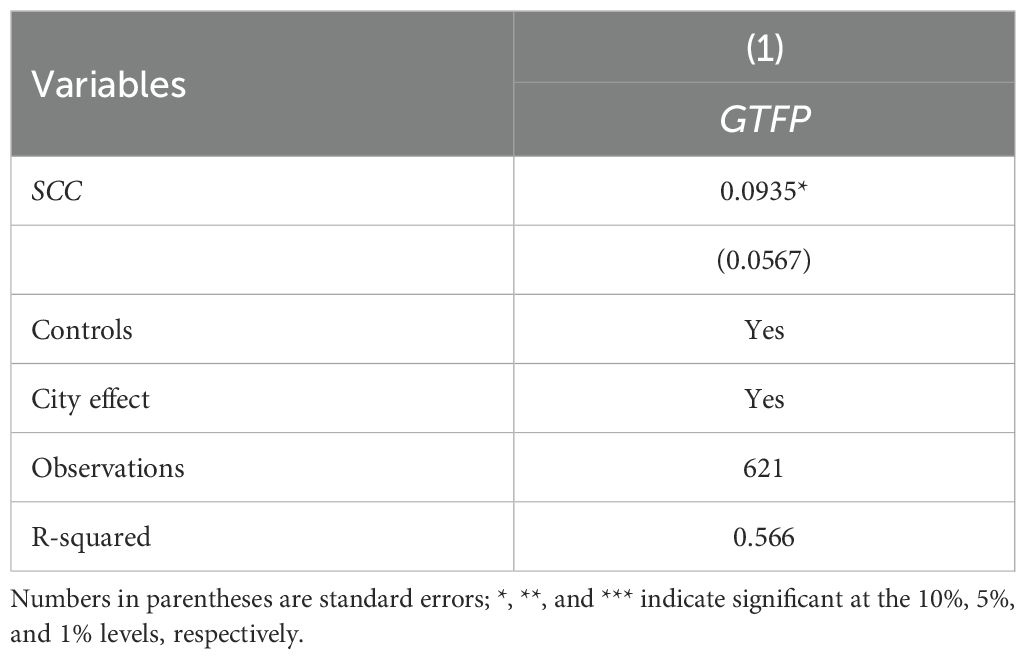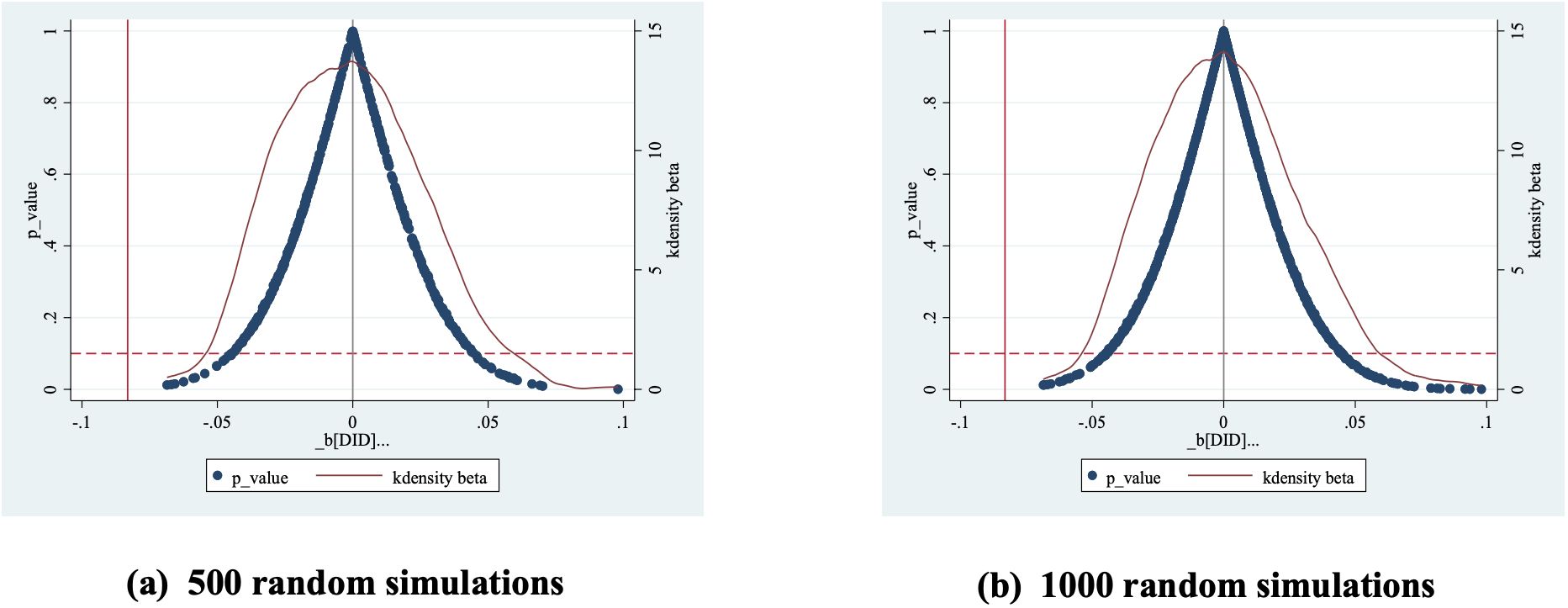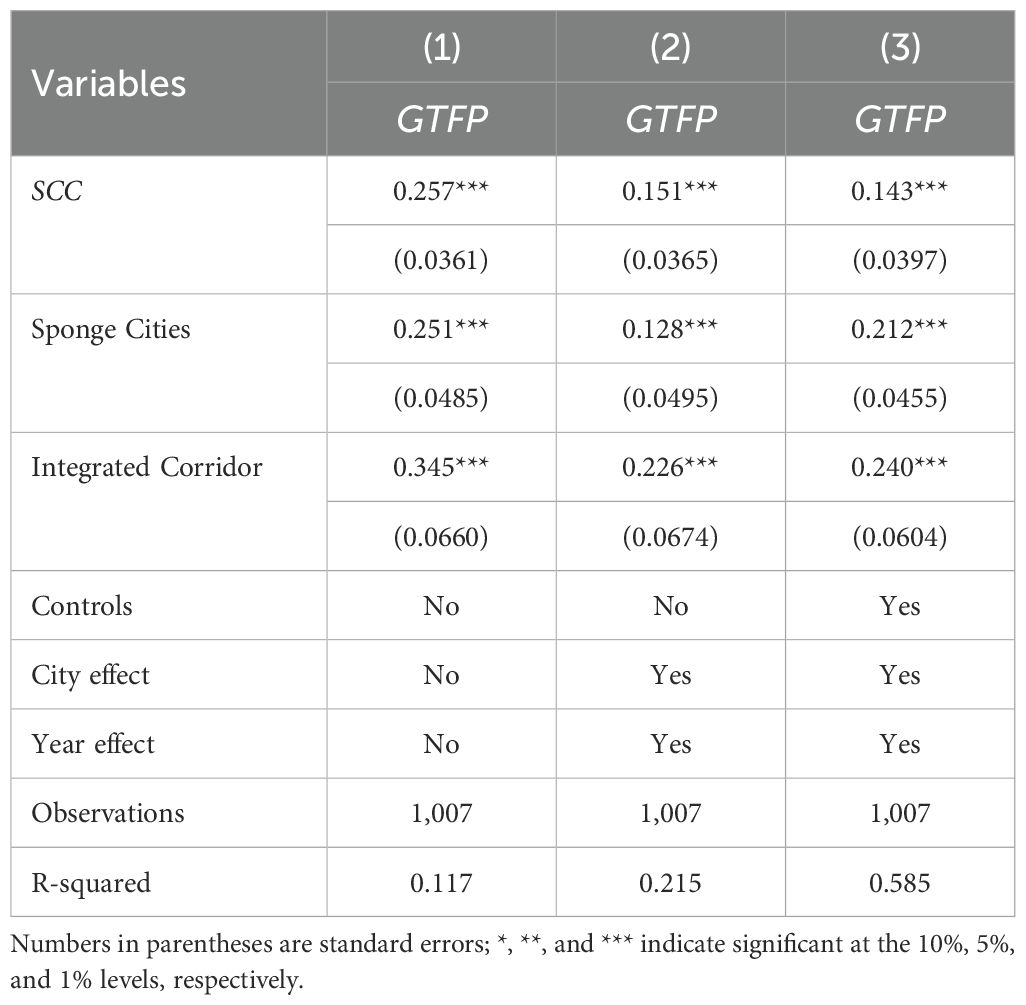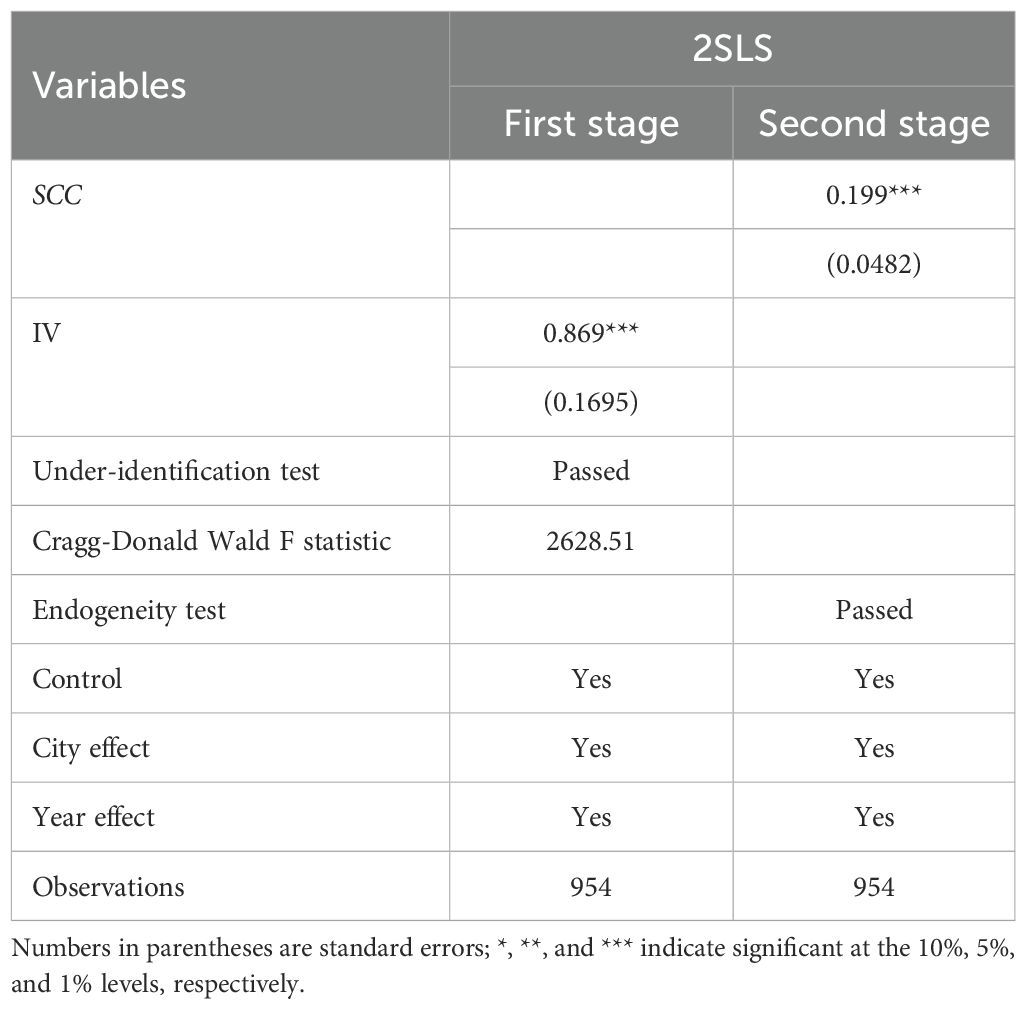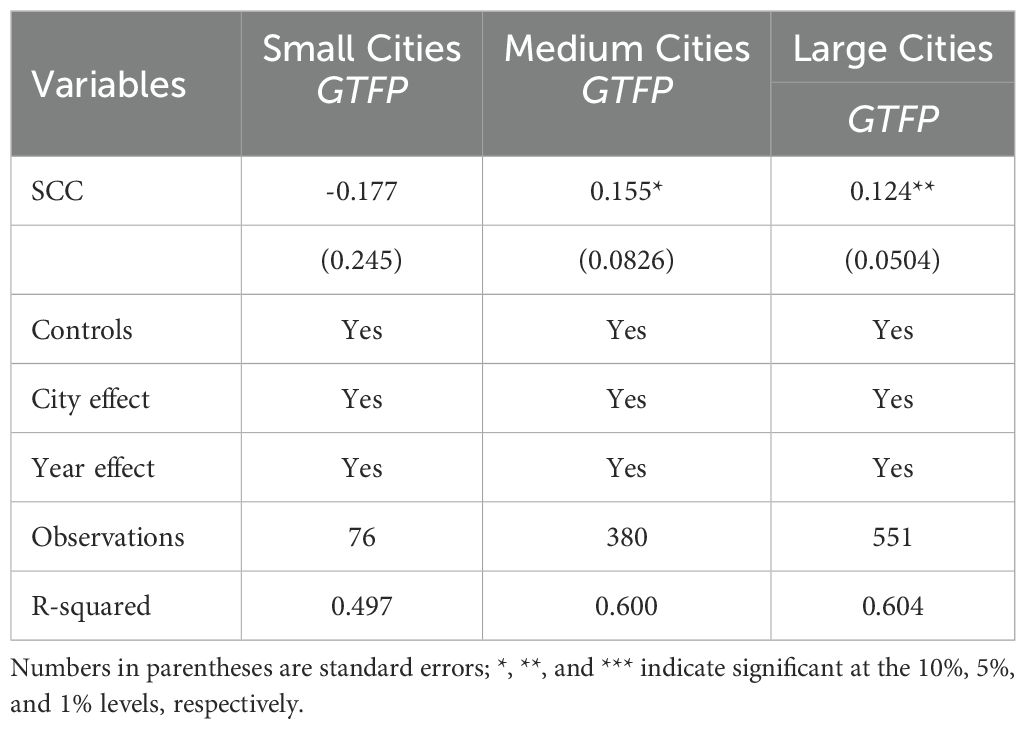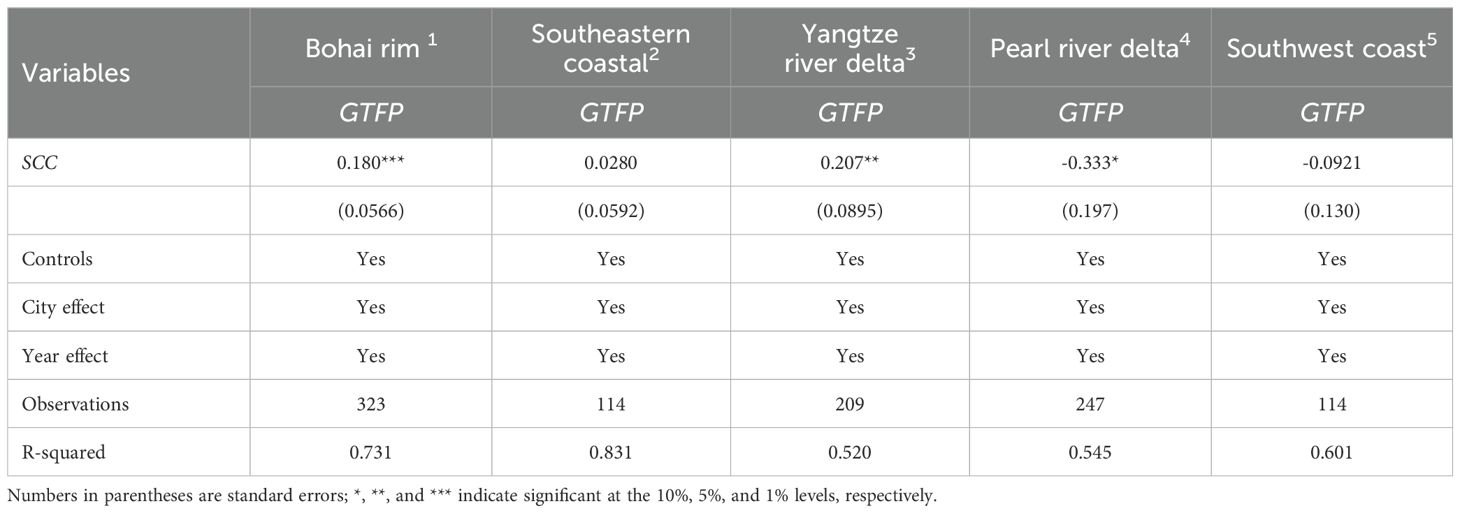- 1Business School, Qingdao University of Technology, Qingdao, Shandong, China
- 2College of Management, Ocean University of China, Qingdao, Shandong, China
- 3The Executive Committee of the Yangtze River Delta Integration Demonstration Zone, Shanghai, China
- 4Institute of Marine Economy and Management, Shandong University of Finance and Economics, Jinan, China
Introduction: As a crucial strategy for promoting urbanization in China, smart city construction introduces new momentum for high-quality economic development through intelligence and informatization. Coastal cities, with their unique geographical and economic advantages, serve as important engines of high-quality economic growth.
Methods: Based on panel data from 53 coastal cities in China from 2003 to 2021, this study uses the super-efficiency SBM-GML index to measure green total factor productivity as an indicator of high-quality economic development and employs a time-varying difference-in-differences model to examine the impact of smart city construction on high-quality economic development in coastal areas.
Results: The findings reveal that (1) Smart city construction significantly enhances high-quality economic development in coastal cities. This conclusion remains valid in parallel trend tests, PSM-DID, placebo tests and endogeneity analysis. (2) The mechanism test shows that smart city construction development primarily promotes high-quality economic growth in coastal cities by facilitating industrial structural upgrading, optimizing resource allocation, and release household consumption potential and expanding domestic demand. However, technological innovation, which is the most important aspect of smart city construction, has not brought new opportunities for high-quality economic development in coastal cities. (3) Heterogeneity analysis shows that the policy effects of smart city are more pronounced in large cities and those with lower levels of scientific and educational development. Additionally, the impact is particularly significant in cities located within the Bohai Rim and Yangtze River Delta port clusters.
Discussion: Based on these findings, continued support for smart city construction is recommended, with differentiated policies tailored to the characteristics of coastal cities and port cluster development levels, alongside advancing industrial structural upgrading, optimizing resource allocation, and fostering new points of consumption growth to promote high-quality economic development in China’s coastal cities.
1 Introduction
According to the World Intellectual Property Organization (WIPO), the core of smart city is key to alleviating the environmental burdens of rapid urbanization. While urbanization promotes economic activity, it can sometimes cause irreversible changes to natural resources and the environment, severely restricting sustainable economic development (Dutta, 2011). Against this backdrop, the concept of “smart city” emerged, aiming to provide a new pathway to solve the dilemma of “urban disease.” China initiated three batches of smart city pilot projects in 2012, 2013, and 2015, vigorously promoting smart city construction (SCC) from the national level, and driving urban intelligent transformation and development. In 2017, the report from the 19th National Congress of the Communist Party of China (CPC) first proposed the important strategy of “high-quality development” marking the shift of China’s economy from a phase of rapid growth to a phase of high-quality development. In 2022, the report from the 20th National Congress of the CPC further proposed making “high-quality development” the primary task in the comprehensive building of a modern socialist country and positioned “high-quality economic development” as the top development goal for the next five years.
As a novel model for urban development, smart city introduces new opportunities for high-quality economic development with intelligence and informatization. Current literature demonstrates that SCC significantly improves high-quality economic development. Entrepreneurial vitality, technological innovation, industrial structural upgrading, and urban resilience as important influencing mechanisms. Nonetheless, there remains a lack of investigation into how smart city promote high-quality economic development from the demand side. Moreover, most existing studies adopt a nationwide perspective. Zhang and Zhao (2021) selected 161 cities across China as their research sample, and Ma (2024) conducted an empirical analysis using panel data from 237 cities nationwide. Thus, studies examining coastal cities, characterized by inherent geographical advantages, high levels of openness, and rapid economic growth, are notably limited.
Coastal cities, as important engines of China’s economic development, rely on their locational advantages near the sea and high levels of openness to play a crucial role in driving high-quality development of urban economic. However, with increasing global economic uncertainty, the relatively weaker domestic and foreign environments and the threat of natural disaster such as typhoons and rising sea levels, coastal cities, more vulnerable to external adverse factors than inland cities that mainly rely on domestic demand-driven and traditional industries (Shen and Li, 2023). Additionally, coastal cities belong to different port clusters that operate independently and compete with one another. They lack an effective linkage mechanism, resulting in significant development gaps between different port clusters, and underutilized regional resource integration. Therefore, studying how SCC can promote high-quality economic development in coastal cities is of significant theoretical and practical importance.
Based on this, this paper selects panel data from 53 coastal cities in China from 2003 to 2021 as the research sample. It empirically analyzes the impact of SCC on high-quality development of economic in coastal cities using the time-varying difference-in-differences (TV-DID) model. And further through the mechanism test from the supply side and demand side to comprehensively examine its specific mechanism of action. Additionally, this paper investigates the differentiated performance of different sizes, different levels of educational and scientific and different port clusters in the construction of smart cities through heterogeneity analysis. Compared to existing research, the contributions of this paper are as follows: First, this paper focuses on coastal cities and systematically analyzes the implementation effects of smart city policies in this region. Second, it comprehensively explores the impact mechanisms of smart cities from both supply and demand sides, extending the scope of existing smart city research. Furthermore, through heterogeneity analysis it reveals the differentiated performance of cities with varying sizes, scientific and educational levels, port clusters in SCC, providing new theoretical support and practical reference for regional coordinated development.
The remainder of the paper is organized as follows: the second part is the literature review; the third part is the theoretical mechanisms and research hypotheses; the fourth part is the research design; the fifth part is the analysis of the empirical results; and the sixth part is the conclusions of the study, policy recommendations and limitations.
2 Literature review
2.1 Research on smart cities
“Smart city” is an advanced form of urban informatization development, a new carrier of contemporary information technology and management mode, which has become an accelerator for national informatization and modernization development (Xie and Gao, 2023). As a multidimensional concept, “smart cities” have been widely studied and explored over the past decade.
The existing literature defines the concept of smart cities from the following several perspectives roughly: (1) Technological perspective: Emphasizes the core role of new-generation information technologies in SCC, suggesting that technology is the foundation for realizing smart cities (Washburn and Sindhu, 2010; Zhou et al., 2024; Shi et al., 2018). (2) Functional perspective: Focuses on how smart cities enhance urban management and governance, emphasizes the application of information technology in urban operations and governance (Harrison et al., 2010; Shi, 2011). (3) Human-centric perspective: Emphasis on people at the core, focusing on how smart cities meet the needs of citizens and improve their quality of life and happiness (Rahmat et al., 2016; Joyce and Javidroozi, 2024; Mathew and Bangwal, 2024).(4) System perspective: Views smart cities as an organic combination of multidimensional elements, emphasizing cross-domain Synergy and integration (Han and Kim, 2024), promoting urban operations and optimization. To date, academia has not reached a unified definition of smart cities. Despite different focuses, all highlight the application of information technology in urban development.
As research deepens, more scholars are using smart city pilot policies as quasi-natural experiments, studying their impacts from various angles, such as environmental pollution (Shi et al., 2018), environmental quality (Cheng et al., 2024), green total factor productivity (Zhan and Li, 2022), employment resilience (Wang et al., 2024a), urban innovation capacity (Gao et al., 2023) and new productivity (Wang et al., 2024b). Additionally, Su et al. (2020) took Jinzhou-Huludao as an example to explore the smart city construction in the context of new urbanization. Razmjoo et al. (2022) explored the critical impact of clean energy and green technologies on smart city development. Joyce and Javidroozi (2024) establishes a framework to systematically discuss how to effectively realize cross-sectoral data sharing (CDS) while complying with data protection legislation (DPL) in the development of SCC. Tonmoy et al. (2020) pointed out, while smart city technologies have great potential, their large-scale urban application in coastal disaster management is still limited. Tao et al. (2020) using Fujian province, China, as an example, suggested that the government should accelerate SCC in coastal areas through top-level design and data sharing to create an upgraded version of smart city.
2.2 Research on high-quality economic development
Because of high levels of economic growth can increase wealth, expanding its potential to address poverty, unemployment, and other social issues, so arouse many countries emphasizes and set high-quality economic development as one of the economic policy goal (Sharipov, 2015). Over the past 40 years of China’s reform and opening up, the national economy has achieved rapid growth, characterized by the rapid expansion of quantity and scale (Jin, 2018). However, as China’s development enters the phase of urbanization and Servicification of the economic structure, the expansion of scale and quantity based on traditional modes of production can no longer satisfy the new characteristics of individualization, diversification and structural upgrading that people are displaying in terms of consumption. At the same time, it is difficult to sustain economic growth by relying on traditional growth methods, and highlight the urgent need to shift development models and identify new growth drivers (Gao et al., 2020). Given these new characteristics, the 19th National Congress of CPC emphasized that “the principal contradiction in Chinese society has evolved into one between the people’s ever-growing need for a better life and unbalanced and inadequate development” and proposed that “China’s economy has transitioned from a phase of rapid growth to one of high-quality development.”
The 20th National Congress of CPC further stressed that “high-quality development is the primary task of building a modern socialist country in all respects.” Jin (2018) pointed out that entering new era of high-quality development, a more genuine and rational new driving mechanism is needed, one that consciously targets the strategic development goals that directly reflect people’s aspirations, this new driving mechanism is innovation-led on the supply side and people’s aspirations on the demand side. Zhao et al. (2019) explained the connotations of high-quality economic development from three perspectives: systemic balance, economic development, livelihood orientation. Gao et al. (2019) using methods from political economy, microeconomics, and macroeconomics, argued that building a modern economic system is an essential pathway for China’s economy to achieve high-quality development. High-quality economic development is the output of high-quality society and governance based on the expanded reproduction of a knowledge-based middle class, with its core economic mechanism being the upgrading of factor quality and innovation. Innovation-driven development is the key internal factor that determines regional differences in high-quality economic development, while fiscal science and technology expenditures and urbanization are significant external forces (Wang and Chen, 2024)
As the core of high-quality development, some scholars use total factor productivity (TFP) to portray high-quality development of urban economy (Sun et al., 2020), while other scholars have constructed different indicator systems to measure it. For instance, Ma et al. (2019) considers that high-quality development is about improving the effectiveness of supply, achieving dynamic equilibrium between supply and demand at a new level, and, based on this, constructed a regional economic high-quality development evaluation system. Chen et al. (2020) based on the “new development philosophy”, built an indicator system for high-quality economic development and measured the provincial-level economic high-quality development index. City as crucial engines and spatial carriers of China-style modernization, research on high-quality economic development is gradually moving closer the city level. Wang and Tang (2022) constructed an indicator system based on the relationship between quantity and quality of high-quality development and measured the level of high-quality economic development at the level of coastal cities clusters. Ming and Peng (2024) constructed an index system from six dimensions: economy, green, society, coordination, innovation, and openness to measure the typical regional Yangtze River Delta region. An et al. (2022) constructed a system of indicators to measure high-quality development of the marine economy based on efficiency, coordination, innovation, sustainability, openness, and shareability and identified coordination, sustainability, and innovation as the main drivers. Zhang et al. (2024b) point out that marine industrial agglomeration has a significant role to play in promoting the high-quality development of the marine economy, which is mainly promoted through four aspects: innovation, coordination, openness and inclusiveness. Liu et al. (2021b) pointed out that the impact of marine technological innovation on the high-quality development of the marine economy is non-linear, and after reaching a certain threshold, this promotional effect gradually diminishes. Moreover, scholars have also researched influencing factors such as smog pollution and government governance (Chen, 2010), innovation factor mismatch (Wang and Hu, 2023), digital economy (Cao, 2024; Ming and Peng, 2024), local government environmental regulations (Jia et al., 2023), and government digital transformation (Guo et al., 2024).
2.3 Research on the impact of smart city construction on high-quality economic development
SCC can attract and aggregate innovative resources, driving technological innovation and organizational transformation, thereby promoting urban economies to leap to a high-quality stage (Caragliu and Del Bo, 2019).
From a micro-level perspective, SCC can promote high-quality corporate development by alleviating financing constraints and reducing operational costs (Liu and Liu, 2022). Additionally, it enhances the high-quality development of export trade through the shared effect of domestic intermediate inputs, the variety effect of imported intermediate goods, and the technological innovation effect (Xie and Gao, 2023).
From a macro-level perspective, SCC has significantly improved the quality of urban development (Zhao and Wu, 2020), Liu et al. (2021a) from a perspective of resilient development also reached similar conclusions and pointed out that existing the positive spatial spillover effect of smart city pilot policy. SCC not only enhances high-quality economic development by impacting the dynamics and outcomes of economic growth (Zhang and Zhao, 2021),but also promotes industrial structure upgrades, stimulates entrepreneurial vitality, strengthens urban resilience, and increases technological investment, all contributing to high-quality economic development (Zhang et al., 2024a; Zhan and Li, 2022; Ma, 2024). Moreover, the development of digital technology and the new generation of information technology industries has led to a demand for highly skilled workers, forcing the labor market to upgrade its skills, boosting the overall level of human capital in the region (Guo et al., 2023) and contributing to high-quality economic development.
Based on the literature review above, it can be found that academia has already laid a certain foundation for research on SCC, high-quality economic development, and the impact of SCC on high-quality economic development, which provides an important reference for the research in this paper. However, there is a lack of in-depth research on the high-quality economic development of coastal cities. Therefore, the possible marginal contributions of this paper are mainly as follows: First, the focus of the research is concentrated on the coastal region. Second, this paper not only describes the impact of smart cities on the high-quality development of coastal cities’ economies through technological innovation, industrial structure upgrading and resource allocation optimization on the supply side, but also illustrates the promotion of high-quality development of coastal cities’ economies through the release of residents’ consumption potential on the demand side. Third, considering that coastal cities belong to different port clusters, analyzing port cluster heterogeneity helps promote coordinated development between coastal cities and across port clusters.
3 Theoretical mechanisms and research hypotheses
SCC, as a new model of urban development, plays a crucial role in promoting high-quality economic development. Smart cities possession the capacity of pool and leverage innovative resources, which is a fundamental force to promote technological advancement and organizational transformation precisely (Ma, 2024). And coastal cities construction relies precisely on the rapidly transformation and upgrading of traditional urban organizations to promote high-quality urban economic development continually.
Smart cities accelerate the development of digital infrastructure in coastal cities by introducing new-generation information technologies and digital platforms. The rapid development of digital infrastructure not only significantly enhances corporate innovation capacity (Yang et al., 2024b) but also boosts overall urban innovation capabilities (Wang and Deng, 2022). At the same time, the development of information infrastructure transforms the original ways resources are combined and connected, reducing contract, agency, and governance costs in the innovation process, cognitive differences was decreased, and establishing an efficient, boundaryless, open innovation network for innovation subjects, stimulates knowledge and creativity exchanges, enhancing the innovation capacity and efficiency of all actors (Zhao et al., 2022). In addition, substantial financial support for the construction of smart cities has led to a greater concentration of innovative elements in the pilot cities, which has contributed to the efficiency of local innovation and creativity (Wang et al., 2022), and boosting coastal cities high-quality economic development. Drawing on the above, this paper proposes:
Hypothesis 1: Smart city construction promotes high-quality economic development by enhancing technological progress and innovation efficiency.
Smart cities, as a product of the high integration of informatization and urbanization, promote the development of emerging industries such as the Internet of Things (IoT), big data, cloud computing, new energy, and information materials. The efficient informatization environment significantly reduces the operating costs of traditional industries, increases productivity, and accelerates the digital transformation of enterprises, thereby optimizing the overall industrial structure (Zhang et al., 2024a). As the industrial structure improves, overall operational efficiency and productivity levels are effectively enhanced (Wang et al., 2024a). SCC optimizes the spatial distribution and structural configuration of industries (Wang and Liu, 2024), mitigating the negative impacts of rapid urbanization in coastal areas on a spatial level (Tian and Zhang, 2024), and thus promoting high-quality economic development. Based on the above, the hypothesis is proposed as follows:
Hypothesis 2: Smart city construction promotes high-quality economic development by driving industrial structure upgrades.
SCC relies on IoT, big data, mobile internet, cloud computing, and other new-generation information technologies and high-tech industries, to achieve the agglomeration of factors of production and the optimization of the structure of resource allocation (Gong et al., 2023). This promotes the transformation of coastal industries toward informatization, networking, and digitalization, reducing resource waste and improving factor allocation efficiency (Zhang and Zhao, 2021). Smart city development can significantly enhance capital allocation efficiency (Cui et al., 2024) and alleviate labor factor mismatches (Cao et al., 2023; Chen et al., 2024), increasing the mobility of factors, allowing more capital and high-quality labor factor to flow into more productive sectors, thereby continuously improving total factor productivity. Additionally, smart cities provide the support for government management of intellectualization, reducing public resource waste caused by information asymmetry thus promoting high-quality urban economic development. Based on the above, this article proposes:
Hypothesis 3: Smart city construction promotes high-quality economic development by optimizing resource allocation.
SCC drives the development of emerging industries such as IoT, big data, cloud computing, and artificial intelligence, optimizing the industrial structure and consumption environment, thus satisfying the basic consumption needs of residents. At the same time, diverse and personalized consumption demands are unleashed (Zeng and Zhong, 2021). The application of emerging technologies breaks the traditional limitations of time and space, reduces transaction costs, allowing the market to adjust product prices more effectively, thereby enhancing consumer motivation and increasing current consumption expenditures (Du, 2017; Huang and Dou, 2024). The development of digital information technology helps mitigate information asymmetry, optimizing consumer decision-making. Meanwhile, the widespread use of mobile internet and the rapid development of digital payment platforms improve consumer habits and consumption quality (Li et al., 2020; Zhong and Zeng, 2022). Additionally, SCC continues to foster new high-tech and high-quality products, new-consumer demand is created. The emergence of new economic forms, such as smart healthcare and smart governance, also improves the quality of life, especially for disadvantaged groups (Makkonen and Inkinen, 2024). High-quality urban public services attract more floating populations to settle and promote the development of coastal tourism, driving local consumption growth and promoting high-quality economic development (Yang et al., 2024a). Therefore, another hypothesis is proposed as follows:
Hypothesis 4: Smart city construction promotes high-quality economic development by release the consumption potential of residents.
Based on the analysis above, the theoretical analysis frame as shown in Figure 1.
4 Research design
4.1 Model setup
This paper treats the smart city pilot policy as a quasi-natural experiment. Since the smart city pilot were conducted in three batches and the traditional DID model assumes that all individuals in the treatment group begin to receive policy shocks at exactly the same point in time, it cannot deal with the problem of inconsistency in the point in time at which individuals in the treatment group receive the treatment. Therefore, the TV-DID model (Callaway and Sant’Anna, 2020) is used to assess the impact of SCC on high-quality economic development in this paper.
Following the basic steps of the TV-DID model, two dummy variables are constructed: (1) Group dummy variable: the treatment group includes cities selected as smart city pilot, which are assigned a value of 1; the control group includes non-pilot cities, assigned a value of 0. (2) Policy time dummy variable: set to 1 after the city was approved as a smart city pilot, and 0 before approval. To mitigate the omitted variable bias, a two-way fixed effects model is used in this paper. Based on the above analysis, the TV-DID model is set as follows:
In formula (1), GTFP represents the dependent variable, high-quality economic development, measured by equation (2) - (4); i represents cities, and t represents years; is the constant term; is the coefficient for the impact of smart city pilot policies on high-quality economic development, which is the core estimation coefficients in this paper; is the interaction term representing the smart city policy dummy variable; represents the estimated coefficients of the control variables; represents the control variables; is the time fixed effect; is the city fixed effect; and is the random error term.
4.2 Variable descriptions
4.2.1 Dependent variable
High-quality economic development is a comprehensive concept that covers not only economic factors but also other non-economic. The measurement results vary significantly due to the subjective selection of indicators. While TFP is the core indicator to represent the quality of economic development in modern economics and is the driving force for long-term sustainable economic growth. Drawing on the research approach of Zhan and Li (2022), this paper constructs green total factor productivity (GTFP) to measure the level of high-quality economic development, with the specific indicators shown in Table 1.
The super-efficiency SBM-GML model is used to measure high-quality economic development level (GTFP). Compared to the traditional SBM model, the super-efficiency SBM model (Tone, 2002) can solve the issue of ranking when multiple decision-making units (DMUs) have efficiency values of 1, reflects the static efficiency of the GTFP.
The specific calculation formula is as follows:
Where x is the input variable of each decision-making unit, y represents the output variables, i and q represent the number of input and output indicators, and are slack variables for input, desirable output, and undesirable output, respectively, and is the weight vector for input and output. is the efficiency value of the DMU, indicating the GTFP efficiency of each city. The larger , the higher the efficiency. When < 1, it indicates that the DMU is inefficient; if = 1, it means the DMU is fully efficient; if , it implies that either reducing output or increasing input can still lead to efficiency.
The GML index with cross-period comparability characteristics and allows for inconsistent rates of increase or decrease in desirable and undesirable output. The super-efficient SBM model measures efficiency values that respond to static changes, while the GML index is a dynamic change in efficiency over time measured on the basis of static efficiency values, and when the GML index is >1, it represents an increase in GTFP, and vice versa for a decrease. The GML function expression is:
The base period (2003) GTFP is set to 1 and the GTFP for each period (2004-2021) is obtain by cumulative multiplication of the GML index. The cumulative multiplication formula is as follows:
Based on the constructed GTFP evaluation index system, the results of GTFP for 53 coastal cities and five port clusters in China from 2004 to 2021, with 2003 as the base year, are shown in Table 2 (the GTFP here shows the annual average).
From Table 2, we can see that the GTFP of China’s coastal cities and five major port clusters exhibited a trend of initial increase, followed by a slight decline, and then further growth from 2004 to 2021. The Bohai Rim and Pearl River Delta regions showed the most significant overall increases. In contrast, the Southeast coast and Southwest coast experienced more modest gains. The Yangtze River Delta also demonstrated steady growth. These trends suggest that while GTFP improved across regions, progress varied due to differing regional conditions and policy impacts.
4.2.2 Core independent variable
The Ministry of Housing and Urban-Rural Development of the People’s Republic of China proposed the vision of SCC in 2009 and officially launched the smart city pilot program in 2012. The second and third batches were announced in 2013 and 2015, respectively, greatly promoting the development of smart cities. This paper uses city-level panel data to evaluate the impact of smart cities on high-quality economic development. It draws on the data processing method of Shi et al. (2018), excluding cities where a specific county or district within the city was designated as a pilot. Through screened, 15 smart city pilot cities were identified out of the 53 coastal cities, set to the treatment group, while the remaining non-pilot cities is the control group (Figure 2).
4.2.3 Control variables
Several variables that have an impact on high-quality economic development of smart city are included as control variables in the economic model. Referring to existing studies, this paper controlled seven key factors for the following Table 3.
4.3 Data and descriptive analysis of variables
Considering the data availability, panel data from 53 coastal cities from 2003 to 2021 were selected as the research sample. The treatment group includes 15 cities, while the remaining 38 cities is the control group. The lists of smart city pilot cities come from the Ministry of Housing and Urban-Rural Development of the People’s Republic of China. Other relevant data are sourced from the China City Statistical Yearbook, China Urban Construction Statistical Yearbook, China Urban and Rural Construction Statistical Yearbook, the EPS database, and the CSMAR database. Missing values in the data are filled in using interpolation. Descriptive statistics analysis for all dependent, core independent, and control variables are shown in Table 4.
5 Empirical results analysis
5.1 Benchmark regression analysis
Table 5 reports the results of the benchmark regression model (1). From the results in column (1), before adding control variables and fixed effects, the coefficient of impact of smart cities development on high quality economic development of coastal cities is 0.288, which is significant at 1% level. In column (2), after only adding control variables and the estimated coefficient changes to 0.146 and significance is unchanged. In column (3), after further adding city and year fixed effects, the results is still a significant positive correlation, the estimated coefficient is 0.135. This indicates that SCC significantly promote high-quality economic development of coastal cities.
5.2 Robustness tests
5.2.1 Parallel trend test
The effectiveness of the DID model relies on the parallel trend assumption, meaning there should be no trend difference between the treatment and control groups before the exogenous policy shock. To verify if the model meets the parallel trend requirement, this paper incorporates dummy variables for three years before and eight years after the implementation of the smart city pilot policy in the model. The short, capped lines perpendicular to the horizontal axis are the 95 per cent confidence intervals of the regression coefficients of the cross-multiplier terms for the number of periods and the treatment group dummy variable. The parallel trend test graph (Figure 3) show that the confidence interval contains a 0-axis with a non-significant coefficient before the policy was implemented, indicating that there was no significant difference between the treatment and control groups. After the implementation of the policy in 2012, although the coefficient is still insignificant, there is a significant upward trend compared to the previous three years. After 2018, the confidence interval does not include the 0-axis and the coefficient is significant, indicating that the implementation of SCC has created a significant gap between the level of high-quality economic development between the control and the control groups.
5.2.2 PSM-DID test
To address differences in trends between smart cities and other cities, reduce sample selection bias, and counteract TV-DID estimation bias, a PSM-DID approach is used for robustness test. PSM helps eliminate sample selection bias, while DID effectively addresses endogeneity. Before conducting PSM-DID, a propensity score matching effectiveness test is also required. The 1:1 kernel matching method is employed, and Table 6 and Figure 4 demonstrates no significant differences between the treatment and control groups after matching, providing support for the robustness of the PSM-DID model. According to the density function plot of propensity score matching, the probability density of propensity score values of variables between the treatment group and the control group had a large gap, and after matching, the probability densities between the treatment group and the control group were closer, and the matching effect was better, which indicated that propensity score matching was effective.
Before conducting the regression, this paper conducted the existence test of city fixed effects, time fixed effects and city time double fixed effects, and the results show that after PSM, the new sample data only have city fixed effects. Therefore, in the TV-DID regression based on PSM, only city-fixed effects are included. The regression results, as shown in Table 7, confirm that SCC continues to have a significantly positive effect on high-quality economic development in coastal cities, supporting the benchmark regression results.
5.2.3 Placebo test
To ensure the net effect on high-quality economic development is solely due to the smart city pilot policy, an indirect placebo test is conducted. This test performs 500 (a) and 1,000 (b) random simulations on the timing and cities involved in the policy, on the basis of which regression analyses are done on high-quality economic development, derive a distribution figure of spurious regression coefficients. The horizontal dashed line indicates the significance level P=0.1, and a scatter below this dotted line indicates that the coefficients are significant at least at the 10 per cent level, and vice versa. Figures 5A, B show that the spurious regression coefficients are clustered around zero and normally distributed, and that the P values for most of the coefficients after randomization lie above the P value = 0.1 line, indicating that most of the coefficients are not significant at least at the 10% level. It shows that the impact on high quality economic development is fully attributable to the implementation of the smart city pilot policy. The placebo test passes, confirming the robustness of the benchmark regression results.
5.2.4 Excluding other policy interference
The “Sponge City Pilot” policy launched in 2014 and the policy on promoting urban underground utility tunnels in 2015 are closely related to the research in this paper. Drawing on the research approach of Bai and Liu (2018), add to dummy variables for sponge cities and utility tunnel cities in the benchmark regression model to reduce estimation bias. The regression results, as shown in Table 8, demonstrate that, after controlling for these two policies, the positive impact of SCC on high-quality economic development remains significant, validate the benchmark regression results again.
5.2.5 Endogenous treatment
The regression model may have endogeneity problems due to omitted variables, measurement bias, and reverse causation, etc., and the possible endogeneity problems have been dealt with in the previous section. First, the super-efficient SBM-GML index is used to measure the level of high-quality development of China’s economy, and authoritative data from the national as well as prefecture-level municipal statistical bureaus are used as the data source to minimize the estimation bias on the regression results due to data quality. Second, PSM-DID is adopted to alleviate the endogeneity problem caused by the self-selection bias of pilot policies.
To make the estimation results more credible, this paper further utilizes instrumental variables (IV) to further deal with the possible endogeneity problem by using SCC lagged one period as an instrumental variable, and the two-stage least squares method (IV-2SLS) for the regression. To examine the validity of the instrumental variables, the unidentifiable test, weak instrumental variable test, and endogeneity test were conducted. The results of the two-stage regression are shown in Table 9.
The results in Table 9 reject the under-identification and weak instrumental variables and exogenous hypotheses for explanatory variables, indicating that this SCC lag one period is reliable as an instrumental variable. The first stage regression reveals the instrumental variable as an explanatory variable, and the regression result for high quality economic development in coastal cities is significantly positive at the 1% level. The second stage regression reveals dummy SCC as an explanatory variable and the regression result is still significant at the 1% level. It shows that smart cities can enhance the high-quality development of coastal cities’ economy by solving endogenous problems.
5.3 Heterogeneity analysis
5.3.1 Heterogeneity by city size
In 2014, the State Council issued the Notice on Adjusting the Standards for City Size Classification, classifying cities into five categories and seven levels based on the permanent resident population in urban areas. According to this classification, this study categorizes 55 coastal cities into small cities, medium cities, and large cities to examine the differential impact of SCC on high-quality economic development across different city sizes. The results are shown in Table 10.
Table 10 indicates that SCC has a negative and insignificant impact on high-quality economic development in small cities. In medium-sized cities, the impact is positive and significant at the 10% level, while in large cities, the effect is more pronounced, with significance at the 5% level. The potential reason is that large cities generally have higher levels of economic development, stronger technological innovation capabilities, and greater human capital, accelerating the pace of SCC and better matching urban needs. This leads to a more pronounced positive effect on high-quality economic development. In contrast, medium-sized cities, while benefitting from SCC, still lag behind large cities in urbanization, human capital, factor allocation, and industrial transformation. While small cities face more challenges, not only including economic, human capital, industry, and resource allocation issues, but also shortcomings in informatization, technological innovation, and transportation. These large gaps hinder the pace of SCC in these areas, requiring substantial investment and resulting in a negative and insignificant impact.
5.3.2 Heterogeneity by scientific and educational levels
Universities as important research bases that provide valuable scientific and educational resources for high-quality economic development. Draw on the approach of He and Ma (2021), based on whether have a “211 Project” university, dividing the coastal cities into high-science and education cities and low-science and education cities. Table 11 shows that in cities with low scientific and educational levels, SCC has a significant positive impact on high-quality economic development. However, in cities with high scientific and educational levels, the impact is insignificant. This may be because high-level scientific and educational cities already have more mature urbanization, resources, and technological, making the marginal contribution of smart cities to high-quality economic development relatively small.
5.3.3 Heterogeneity by port cluster
The Ministry of Transport has formulated the “National Coastal Port Layout Plan” based on the economic development status and characteristics of different regions, the current conditions of ports, the transportation relationships among ports, and the economic feasibility of major cargo transportation. This plan categorizes China coastal ports into five port clusters: the Bohai Rim, the Yangtze River Delta, the Southeast Coast, the Pearl River Delta, and the Southwest Coast. Based on this layout plan, 53 coastal cities are grouped into the five port clusters for heterogeneity analysis.
According to the results in Table 12, SCC significantly promotes high-quality economic development in coastal cities belonging to the Bohai Rim and Yangtze River Delta port clusters. This may be due to the better economic development in these regions, the high efficiency resource allocation of various production factors, the reasonable layout of the industrial structure and greater capacity of technological innovation that enable SCC to effectively contribute to high-quality economic development. However, the impact is insignificant for cities in the southeast and southwest coastal port clusters and even negative for cities in the southwest coastal cluster. Cities in the southeast port cluster may face challenges such as insufficient urbanization, inefficiencies in resource allocation, and limited technological innovation, leading to diminished marginal effects of SCC. The Pearl River Delta port cluster shows a negative impact at a 10% significance level. The coastal cities included in the Pearl River Delta port cluster have matured and improved in terms of economic development, efficiency of resource allocation, as well as technological innovation and urbanisation level. In this context, SCC may hinder high-quality economic development.
5.4 Mechanism test
To further examine the mechanisms by which SCC promotes high-quality economic development in coastal cities, variables related to technological innovation (tc) and industrial structure upgrading (str) are used, draw on the approaches of Shi et al. (2018) and Du et al. (2020). Technological innovation is measured by the number of patents per capita, and industrial structure upgrading is measured by the ratio of secondary to tertiary industry GDP. Resource allocation is represented by the following variables: degree of openness (do), measured by the ratio of actual foreign capital utilization to GDP; infrastructure level (inf), measured by road area per capita at year-end; financial development level (fd), represented by the ratio of loan to deposit balances; and economic agglomeration (agg), measured by the proportion of entropy in secondary and tertiary industry locations (ratio of the proportion of employees in secondary and tertiary industries in the city to the total number of employees in the city to the proportion of employees in secondary and tertiary industries in the province in which the city is located to the total number of employees in the province). The consumption potential of residents is represented by the actual per capita retail sales of consumer goods in urban areas. The results are shown in Table 13.
According to the results in Table 13, in column (1), it’s showing a negative impact of SCC on technological innovation in coastal cities, indicating that SCC may no longer sustain technological innovation for urban development. Focusing solely on technological innovation related to SCC may hinder the overall technological innovation goals of coastal cities, so Hypothesis 1 is not supported. Column (2) indicate that SCC continues to significantly impact industrial structure transformation and upgrading, support Hypothesis 2. Column (3)-(6) indicate that the development of smart cities positively and significantly impacts the degree of openness and infrastructure level, while it negatively and insignificantly affects financial development and economic agglomeration. Overall, SCC optimizes resource allocation in coastal cities, alleviating resource misallocation, support Hypothesis 3. Column (7) indicate that the influence of SCC has a significant positive impact on the resident consumption potential at the 5% level, Hypothesis 4 is valid.
6 Conclusions, policy recommendations and limitations
6.1 Main findings
This paper empirically demonstrates the impact of smart city pilot policies on high-quality economic development using a TV-DID model based on panel data from 53 prefecture-level cities along the coast of China from 2003 to 2021. The study shows that:
1. The smart city pilot policy has a significant contribution to the economic high-quality development of coastal cities during the sample period and still holds under robust type tests such as PSM-DID, placebo test, and endogeneity analysis.
2. This paper selects technological innovation, industrial structure upgrading, resource allocation (degree of opening up to the outside world, level of financial development, level of infrastructure, and economic agglomeration) and residents’ consumption potential as mechanism variables, and the results show that the construction of the smart city can boost the high-quality development of coastal cities’ economy by promoting industrial structure upgrading and optimizing resource allocation. Technological innovation appears to have limited effectiveness, likely because coastal cities already possess advanced digital platform infrastructure and are highly developed in new-generation information and communication technologies (ICT) such as big data and IoT. This reduces the potential for SCC to drive sustained technological innovation. Nonetheless, SCC, underpinned by data and leveraging advanced ICT, has spurred the emergence of new industries, optimized industrial structures, and promoted economic diversification. Additionally, SCC facilitates the continuous flow of high-quality resources into more productive sectors, enhancing resource allocation efficiency. By mitigating resource mismatches, it improves the operational efficiency of coastal city economies and drives high-quality economic development.
3. The policy effects of SCC vary significantly across city sizes, levels of science and education, and belonging to different port clusters. Among them, large cities and above enjoy greater policy dividends from SCC than small and medium-sized cities. This may be attributed to the comparative advantages of large cities in terms of infrastructure, capital resources and innovation capacity, which enable them to better fit the smart city pilot policies to promote high-quality economic development. The policy effects of smart city building are greater for coastal cities with low levels of science and education than for coastal cities with high levels of science and education. This suggests that smart city development may have narrowed the gap between coastal cities with different levels of science and education, providing them with educational and technological support that was previously inadequate or lacking. In terms of the different port clusters, the policy effect of SCC is more pronounced on the high-quality economic development of coastal cities belonging to the Bohai Rim and the Yangtze River Delta than those belonging to the Southeast Coast, the Pearl River Delta, and the Southwest Coast, which is probably due to the lack of effective synergies between port clusters, and the phenomenon of fragmentation not only affects the overall efficiency of the construction of smart cities but also reduces the impact of the policy on the high-quality development of economy.
6.2 Policy recommendations
According to the above conclusions, this paper proposes following policy recommendations.
1. Continuing to promote SCC to enhance high-quality economic development. Make full use of the smart city pilot policy to promote the process of SCC. Firstly, the government should provide stable long-term financial support and policy incentives to attract more enterprises and investors to participate in SCC. Secondly, the policy implementation of SCC should be strengthened. In the process of policy implementation, it is necessary to strengthen communication and coordination between the central government and local authorities to avoid a significant reduction in policy effects due to inadequate implementation. It is recommended that a special monitoring and evaluation mechanism be set up to dynamically monitor and evaluate the effectiveness of the pilot policy, so as to ensure that problems are identified, and programs are optimized in a timely manner during the implementation of the policy. Finally, pilot policy funding and technical support need to be upgraded. A special pool of funds should be set up to provide stable financial support for key areas in SCC (e.g., smart transport, smart government and intelligent infrastructure construction); at the same time, social capital and technology enterprises should be encouraged to participate in order to provide diversified resources for SCC. Through these measures, policy dividends can be further released to realize the territory-wide high-quality development of coastal cities.
2. SCC should focus on technological innovation and industrial structure upgrading, optimize resource allocation, and release consumption potential of resident, and comprehensively enhance the high-quality economic development of coastal cities. In terms of upgrading the industrial structure, SCC should be used as an opportunity to promote the digital transformation of traditional industries and the cultivation of new industries. Pilot smart cities should focus on creating regional characteristic industrial clusters, transforming traditional industrial chains using technologies such as big data, IoT and artificial intelligence, while increasing policy support for emerging economic sectors (such as smart manufacturing, digital services and new energy industries) to enhance the level of industrial diversification and added value. In terms of resource allocation optimization, it is proposed to build a cross-regional resource synergy platform based on smart technologies to enhance resource flow and allocation efficiency through data sharing, intelligent scheduling and refined management. For example, a smart logistics platform is used to integrate port, railway and air transport resources, reduce logistics costs and improve inter-regional synergy efficiency. To address resource mismatch in coastal cities, priority can be given to guiding high value-added industries to absorb more capital and high-end human resources and improve production efficiency. In terms of unleashing consumption potential, the construction of smart consumption scenarios that are highly relevant to residents’ daily lives, such as smart retail, smart payment and smart travelling, should be accelerated. At the same time, combining with the specialty economies of coastal cities (such as tourism and marine economy), consumption upgrading of local residents and foreign tourists should be promoted. In addition, accurate smart livelihood services (e.g. smart healthcare and online education) can be used to boost residents’ consumption confidence and expand effective demand.
3. Formulate differentiated policies to fully harness the potential and strengths of various cities. Firstly, in terms of city scale, priority should continue to be given to supporting the construction of smart cities in large cities, giving full play to their advantages in terms of infrastructure, capital resources and innovation capacity, so as to create a model smart city with international competitiveness. At the same time, in order to prevent small and medium-sized cities from being marginalized due to a lack of resources, special support programs for small and medium-sized cities should be set up to provide technology transfer and financial support to help them overcome the problem of ‘difficult start’ in SCC and narrow the gap with large cities. Secondly, in view of the different levels of science and education in cities, the resources of smart cities in the field of education and science and technology should be strengthened. For cities with a low level of science education, they should focus on promoting the construction of smart education platforms, such as popularizing online learning systems and virtual laboratories, in order to enhance local education and scientific research capabilities; for cities with a high level of science education, they can increase the investment in high-end scientific research projects to promote the continuous breakthroughs in the research and development of smart city technologies, so as to enhance their international competitiveness in the field of smart economy. Finally, in promoting the development of port clusters, the synergistic development of ports should be deepened. Especially in the Bohai Rim and Yangtze River Delta regions, the smart transformation and linkage of port clusters should be further promoted to improve the overall efficiency of the regional economy through the integration of the logistics network, the optimization of the supply chain management and the data sharing platform. For regions such as the Southeast Coast, the Pearl River Delta and the Southwest Coast, synergies within and outside the region should be strengthened to overcome the weakening of policy effects brought about by port fragmentation.
6.3 Limitations and future research directions
Economic high-quality development, as a comprehensive indicator, contains multiple dimensions such as economic, social, and ecological. GTFP, as the core of economic high-quality development, can portray the level of economic high-quality development to a certain extent. In the future, a comprehensive multi-dimensional analysis framework and indicator system can be established to provide a comprehensive measurement of high-quality economic development. Another limitation is that the impact of the smart city pilot policy may take a long time to appear. The static model adopted in this paper may not be able to reflect the full impact of the policy as well as the time-differentiated effects at different stages of development. Therefore, the next study can conduct a comprehensive analysis from both static and dynamic aspects. Finally, in terms of mechanism analysis, future research can further explore the important influencing mechanisms on the demand side and construct the cross-sectional distribution of these mechanisms to study the heterogeneous influence of the mechanisms.
Data availability statement
The original contributions presented in the study are included in the article/supplementary material. Further inquiries can be directed to the corresponding author.
Author contributions
LW: Conceptualization, Formal analysis, Funding acquisition, Methodology, Software, Supervision, Visualization, Writing – original draft, Writing – review & editing. FL: Data curation, Formal analysis, Methodology, Software, Writing – original draft. YG: Supervision, Writing – review & editing. KY: Conceptualization, Supervision, Writing – review & editing.
Funding
The author(s) declare financial support was received for the research, authorship, and/or publication of this article. This work was supported by the National Social Science Foundation of China (16AZD018) and Humanities and Social Sciences Youth Foundation of Ministry of Education of China (24YJCZH298).
Acknowledgments
Funding from the National Social Science Foundation of China (16AZD018) and Humanities and Social Sciences Youth Foundation of Ministry of Education of China (24YJCZH298) is gratefully acknowledged.
Conflict of interest
The authors declare that the research was conducted in the absence of any commercial or financial relationships that could be construed as a potential conflict of interest.
Generative AI statement
The author(s) declare that no Generative AI was used in the creation of this manuscript.
Publisher’s note
All claims expressed in this article are solely those of the authors and do not necessarily represent those of their affiliated organizations, or those of the publisher, the editors and the reviewers. Any product that may be evaluated in this article, or claim that may be made by its manufacturer, is not guaranteed or endorsed by the publisher.
Footnotes
- ^ Bohai Rim port group, consisting of Liaoning, Tianjin, Hebei and Shandong coastal port clusters
- ^ A group of ports in the southeastern coastal region, dominated by the ports of Xiamen and Fuzhou, including Quanzhou, Putian, and Zhangzhou
- ^ A group of ports in the Yangtze River Delta region, including the ports of Shanghai, Ningbo and Lianyungang as the main ports, and ports along the coast and in the lower reaches of the Yangtze River, such as Zhoushan, Wenzhou, Nanjing, Zhenjiang, Nantong, Suzhou, etc.
- ^ Pearl River Delta (PRD) ports group, comprising ports in the eastern part of Guangdong and the Pearl River Delta (PRD) region
- ^ The group of ports in the southwestern coastal region consists of ports in western Guangdong, coastal Guangxi and Hainan Province.
References
An D., Shen C., Yang L. (2022). Evaluation and temporal-spatial deconstruction for high-quality development of regional marine economy: A case study of China. Front. Mar. Sci. 9. doi: 10.3389/fmars.2022.916662
Bai J. H., Liu Y. Y. (2018). Can foreign direct investment improve resource misallocation in China? China Ind. Econ., 60–78. doi: 10.19581/j.cnki.ciejournal.20180115.002
Callaway B., Sant’Anna P. H. C. (2020). Difference-in-Differences with Multiple Time Periods. Available online at: http://arxiv.org/abs/1803.09015 (Accessed November 11, 2024).
Cao P. (2024). Digital economy enabling China’s high-quality economic development: impact paths, opportunities and challenges. J. Educ. Humanit. Soc Sci. 35, 273–280. doi: 10.54097/ta41p150
Cao Y., Hu Y., Liu Q., Lu M., Shan Y. (2023). Job creation or disruption? Unraveling the effects of smart city construction on corporate employment in China. Technol. Forecast. Soc Change 195, 122783. doi: 10.1016/j.techfore.2023.122783
Caragliu A., Del Bo C. F. (2019). Smart innovative cities: The impact of Smart City policies on urban innovation. Technol. Forecast. Soc Change 142, 373–383. doi: 10.1016/j.techfore.2018.07.022
Chen C., Li S.-E., Wang L. (2024). Can smart cities reduce labor misallocation? Evidence from China. Technol. Forecast. Soc Change 201, 123264. doi: 10.1016/j.techfore.2024.123264
Chen J. H., Chen Y., Chen M. M. (2020). High-quality development level, regional differences, and dynamic evolution of China’s economy. J. Quant. Econ. Tech. Econ. Res. 37, 108–126. doi: 10.13653/j.cnki.jqte.2020.12.006
Chen S. Y. (2010). China’s green industrial revolution: an explanation from the perspective of environmental total factor productivity, (1980-2008). Econ. Res. 45, 21–34+58.
Cheng W., Ouyang X., Yu A., Shen Z., Vardanyan M. (2024). Subjective perceptions versus objective outcomes: Assessing the impact of smart city pilots on environmental quality in China. Technol. Forecast. Soc Change 209, 123799. doi: 10.1016/j.techfore.2024.123799
Cui S., Li G., Liu J. (2024). Can the construction of smart cities promote the capital allocation efficiency: Evidence from China. Technol. Forecast. Soc Change 208, 123677. doi: 10.1016/j.techfore.2024.123677
Du D. Q. (2017). Research on the driving mechanism of internet promoting consumption upgrading. Economist, 48–54. doi: 10.16158/j.cnki.51-1312/f.2017.03.008
Du J. G., Wang Y., Zhao A. W. (2020). Research on the impact and mechanism of smart city construction on urban green development. Soft Sci. 34, 59–64. doi: 10.13956/j.ss.1001-8409.2020.09.09
Dutta S. ed. (2011). The Global Innovation Index 2011: Accelerating Growth and Development. INSEAD World Intellect. Prop. Organ. WIPO. Available at: https://ww.wipo.int/edocs/pubdocs/en/economics/gii/gii_2011.pdf.
Gao F., Lv Y. Q., Chen J., Lv J. (2023). Research on the green technological innovation effects of “Smart city” Pilot Projects. Sci. Res. Manage. 44, 85–94. doi: 10.19571/j.cnki.1000-2995.2023.06.009
Gao P. Y., Du C., Liu X. H., Yuan F. H., Tang D. D. (2019). Construction of a modern economic system under the context of high-quality development: A logical framework. Econ. Res. 54, 4–17.
Gao P. Y., Yuan F. H., Hu H. G., Liu X. H. (2020). The dynamics, mechanisms, and governance of high-quality development. Econ. Res. 55, 4–19.
Gong M., Zeng Y., Zhang F. (2023). New infrastructure, optimization of resource allocation and upgrading of industrial structure. Finance Res. Lett. 54, 103754. doi: 10.1016/j.frl.2023.103754
Guo C. Y., Teng Y. C., Zang W. J. (2024). The impact of government digital transformation on high-quality economic development: an empirical test based on Chinese Cities. Explor. Econ. Issues, 71–86.
Guo B., Wang Y., Zhang H., Liang C., Feng Y., Hu F. (2023). Impact of the digital economy on high-quality urban economic development: Evidence from Chinese cities. Econ. Model. 120, 106194. doi: 10.1016/j.econmod.2023.106194
Han M. J. N., Kim M. J. (2024). A systematic review of smart city research from an urban context perspective. Cities 150, 105027. doi: 10.1016/j.cities.2024.105027
Harrison C., Eckman B., Hamilton R., Hartswick P., Kalagnanam J., Paraszczak J., et al. (2010). Foundations for smarter cities. IBM J. Res. Dev. 54, 1–16. doi: 10.1147/JRD.2010.2048257
He L. Y., Ma Q. S. (2021). Can smart city pilot enhance urban innovation levels? — Empirical evidence based on multiple period DID. J. Finance Trade Res. 32, 28–40. doi: 10.19337/j.cnki.34-1093/f.2021.03.003
Huang M. Y., Dou X. M. (2024). How does digital economy development release residents’ Consumption potential? J. Shanghai Univ. Finance Econ. 26, 79–93. doi: 10.16538/j.cnki.jsufe.2024.01.006
Jia J. X., Luo L. H., Gu J. (2023). Local government environmental regulation and high-quality economic development. China Ind. Econ. 99–117. doi: 10.19581/j.cnki.ciejournal.2023.05.006
Jin B. (2018). Economic research on “High-quality development. China Ind. Econ., 5–18. doi: 10.19581/j.cnki.ciejournal.2018.04.001
Joyce A., Javidroozi V. (2024). Smart city development: Data sharing vs. data protection legislations. Cities 148, 104859. doi: 10.1016/j.cities.2024.104859
Li J., Wu Y., Xiao J. J. (2020). The impact of digital finance on household consumption: Evidence from China. Econ. Model. 86, 317–326. doi: 10.1016/j.econmod.2019.09.027
Liu C. J., Hu Y. L., Li H. Q., Zhang N. (2021a). The impact of China’s smart city pilot policies on urban development quality — A resilience development perspective. Urban Probl., 79–89. doi: 10.13239/j.bjsshkxy.cswt.211109
Liu W. L., Liu H. N. (2022). Mechanisms and paths for smart city construction to promote high-quality development of enterprises. J. Shenzhen Univ. Humanit. Soc Sci. 39, 95–106.
Liu P., Zhu B., Yang M. (2021b). Has marine technology innovation promoted the high-quality development of the marine economy? ——Evidence from coastal regions in China. Ocean Coast. Manage. 209, 105695. doi: 10.1016/j.ocecoaman.2021.105695
Ma Z. (2024). Research on the impact of smart city construction on high-quality economic development: an analysis from the perspective of urban resilience. East China Econ. Manage. 38, 47–57. doi: 10.19629/j.cnki.34-1014/f.230909015
Ma R., Luo H., Wang H. W., Wang T. C. (2019). Evaluation index system and measurement research on high-quality development of China’s regional economy. China Soft Sci., 60–67.
Makkonen T., Inkinen T. (2024). Inclusive smart cities? Technology-driven urban development and disabilities. Cities 154, 105334. doi: 10.1016/j.cities.2024.105334
Mathew B. P., Bangwal D. (2024). People centric governance model for smart cities development: A systematic review, thematic analysis, and findings. Res. Glob. 9, 100237. doi: 10.1016/j.resglo.2024.100237
Ming C. Q., Peng H. L. (2024). Digital economy, high-quality urban economic development, and spatial spillover effects — An empirical study based on 26 cities in the yangtze river delta. East China Econ. Manage. 38, 25–35. doi: 10.19629/j.cnki.34-1014/f.240203014
Rahmat A., Syadiah N., Subur B. (2016). Smart coastal city: sea pollution awareness for people in Surabaya Waterfront City. Proc. - Soc Behav. Sci. 227, 770–777. doi: 10.1016/j.sbspro.2016.06.144
Razmjoo A., Gandomi A. H., Pazhoohesh M., Mirjalili S., Rezaei M. (2022). The key role of clean energy and technology in smart cities development. Energy Strategy Rev. 44, 100943. doi: 10.1016/j.esr.2022.100943
Sharipov I. (2015). Contemporary economic growth models and theories: A literature review. CES Work. Pap. 7, 759–773.
Shen J. S., Li F. H. (2023). Research on the impact of trade facilitation on the economic vitality of coastal cities. J. Cap. Univ. Econ. Bus. 25, 33–47. doi: 10.13504/j.cnki.issn1008-2700.2023.06.003
Shi L. (2011). The principle of smart city and its function and significance in China‘s urban development. China Sci. Technol. Forum, 97–102. doi: 10.13580/j.cnki.fstc.2011.05.017
Shi D. Q., Ding H., Wei P., Liu J. J. (2018). Can smart city construction reduce environmental pollution. China Ind. Econ., 117–135. doi: 10.19581/j.cnki.ciejournal.2018.06.008
Su L., Fan J., Fu L. (2020). Exploration of smart city construction under new urbanization: A case study of Jinzhou-Huludao Coastal Area. Sustain. Comput. Inform. Syst. 27, 100403. doi: 10.1016/j.suscom.2020.100403
Sun H., Gui H. Q., Yang D. (2020). Measurement and evaluation of high-quality economic development in China’s provincial regions. Zhejiang Soc Sci., 4–14+155. doi: 10.14167/j.zjss.2020.08.001
Tao S., Liu H., Wang S., Li C. (2020). Construction of smart coastal cities based on digital government. J. Coast. Res. 110, 154–158. doi: 10.2112/JCR-SI110-037.1
Tian X., Zhang H. (2024). Analysis of the impact factors of industrial structure upgrading on green total factor productivity from the perspective of spatial spillover effects. Heliyon 10, e28660. doi: 10.1016/j.heliyon.2024.e28660
Tone K. (2002). A slacks-based measure of super-efficiency in data envelopment analysis. Eur. J. Oper. Res. 143, 32–41. doi: 10.1016/S0377-2217(01)00324-1
Tonmoy F. N., Hasan S., Tomlinson R. (2020). Increasing coastal disaster resilience using smart city frameworks: current state, challenges, and opportunities. Front. Water 2. doi: 10.3389/frwa.2020.00003
Wang Y. J., Chen X. Y. (2024). Sources of disparities and formation mechanisms in China’s high-quality economic development. Shandong Soc Sci., 152–160. doi: 10.14112/j.cnki.37-1053/c.2024.04.010
Wang J., Deng K. (2022). Impact and mechanism analysis of smart city policy on urban innovation: Evidence from China. Econ. Anal. Policy 73, 574–587. doi: 10.1016/j.eap.2021.12.006
Wang W., Hu L. Z. (2023). The impact of innovation factor misallocation on the high-quality economic development of Chinese urban clusters. J. Manage. 36, 60–75.
Wang D., Liang Y. F., Dou W. (2024a). How does urban industrial structure upgrading affect green productivity? The moderating role of smart city development. Struct. Change Econ. Dyn. S0954349X24001449. doi: 10.1016/j.strueco.2024.09.017
Wang Q., Liu Y. (2024). Beautifying urban environment: Smart city construction and sustainable pollution control in China. J. Environ. Manage. 371, 123262. doi: 10.1016/j.jenvman.2024.123262
Wang K.-L., Pang S.-Q., Zhang F.-Q., Miao Z., Sun H.-P. (2022). The impact assessment of smart city policy on urban green total-factor productivity: Evidence from China. Environ. Impact Assess. Rev. 94, 106756. doi: 10.1016/j.eiar.2022.106756
Wang Y. N., Tang X. B. (2022). Measuring and analyzing the high-quality development of coastal city clusters under the new development pattern. China Circ. Econ. 36, 67–77. doi: 10.14089/j.cnki.cn11-3664/f.2022.02.007
Wang J., Zhang J. Y., Liu G. (2024b). Smart city construction and new-quality productive forces: reflections based on nordhaus’s question. J. Yunnan Univ. Finance Econ. 40, 47–64. doi: 10.16537/j.cnki.jynufe.000976
Xie S. X., Gao X. R. (2023). The relationship between smart city construction and high-quality development of export trade. Econ. Surv. 40, 69–81. doi: 10.15931/j.cnki.1006-1096.2023.04.008
Yang D. M., Bai X. H., Wan D. X. (2024a). Research on the employment effects of smart city pilot construction. Econ. Manage. Rev. 40, 135–148. doi: 10.13962/j.cnki.37-1486/f.2024.05.011
Yang S., Jahanger A., Usman M. (2024b). Examining the influence of green innovations in industrial enterprises on China’s smart city development. Technol. Forecast. Soc Change 199, 123031. doi: 10.1016/j.techfore.2023.123031
Zeng J. H., Zhong R. Y. (2021). Has the internet driven consumption upgrade? — A study based on urban consumption search index in Guangdong Province. Economist, 31–41. doi: 10.16158/j.cnki.51-1312/f.2021.08.005
Zhan Y., Li S. (2022). Smart city construction, entrepreneurial vitality, and high-quality economic development: an analysis from the perspective of green total factor productivity. Financ. Res. 48, 4–18. doi: 10.16538/j.cnki.jfe.20211015.101
Zhang R., Gao Q., Gao K. (2024b). Impact of marine industrial agglomeration on the high-quality development of the marine economy——A case study of China’s coastal areas. Ecol. Indic. 158, 111410. doi: 10.1016/j.ecolind.2023.111410
Zhang D., Zhang Q., Li F. Q. (2024a). Research on the impact of smart city construction on urban economic high-quality development — An empirical test based on urban panel data. Price Theory Pract., 158–162. doi: 10.19851/j.cnki.CN11-1010/F.2024.01.020
Zhang Z. D., Zhao B. W. (2021). The impact of smart city construction on the high-quality development of urban economy - an empirical analysis based on the difference-in-differences method. Soft Sci. 35, 65–70+129. doi: 10.13956/j.ss.1001-8409.2021.11.11
Zhao J. B., Shi D., Deng Z. (2019). Research on the connotation of high-quality development. Econ. Manage. Res. 40, 15–31. doi: 10.13502/j.cnki.issn1000-7636.2019.11.002
Zhao H. P., Tian X. L., Zhang S. D. (2022). The mechanism and empirical testing of smart city construction’s impact on high-quality economic development. Stat. Decis. 38, 102–105. doi: 10.13546/j.cnki.tjyjc.2022.12.020
Zhao C. J., Wu B. J. (2020). Does smart city construction promote the improvement of urban development quality? — Policy effect evaluation based on time-varying DID method. Econ. Rev. 37, 18–27. doi: 10.15931/j.cnki.1006-1096.20201010.008
Zhong R. Y., Zeng J. H. (2022). Research on the impact of digital economy on resident consumption: an empirical analysis based on spatial durbin model. Explor. Econ. Issues, 31–43.
Keywords: smart city, coastal cities, high-quality economic development, super-efficiency SBM-GML index, time-varying DID model
Citation: Wang L, Li F, Gao Y and Yin K (2025) Impact of smart city construction policy on high-quality economic development of coastal cities. Front. Mar. Sci. 11:1519398. doi: 10.3389/fmars.2024.1519398
Received: 29 October 2024; Accepted: 09 December 2024;
Published: 08 January 2025.
Edited by:
Song Ding, Zhejiang University of Finance and Economics, ChinaReviewed by:
Yu Feng, Nanjing University of Aeronautics and Astronautics, ChinaZheng-xin Wang, Zhejiang University of Finance and Economics, China
Copyright © 2025 Wang, Li, Gao and Yin. This is an open-access article distributed under the terms of the Creative Commons Attribution License (CC BY). The use, distribution or reproduction in other forums is permitted, provided the original author(s) and the copyright owner(s) are credited and that the original publication in this journal is cited, in accordance with accepted academic practice. No use, distribution or reproduction is permitted which does not comply with these terms.
*Correspondence: Kedong Yin, eWlua2Vkb25nc2R1ZmVAMTI2LmNvbQ==
 Lihong Wang
Lihong Wang Feng Li
Feng Li Yang Gao3
Yang Gao3